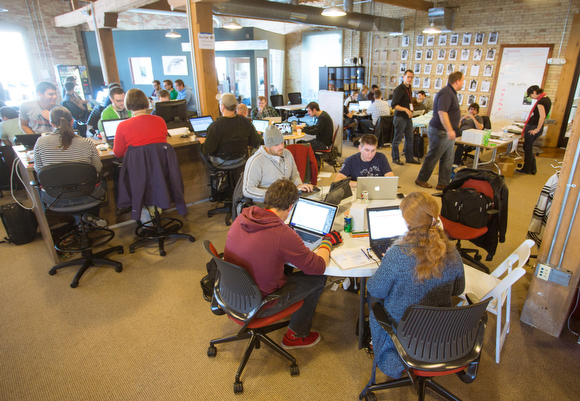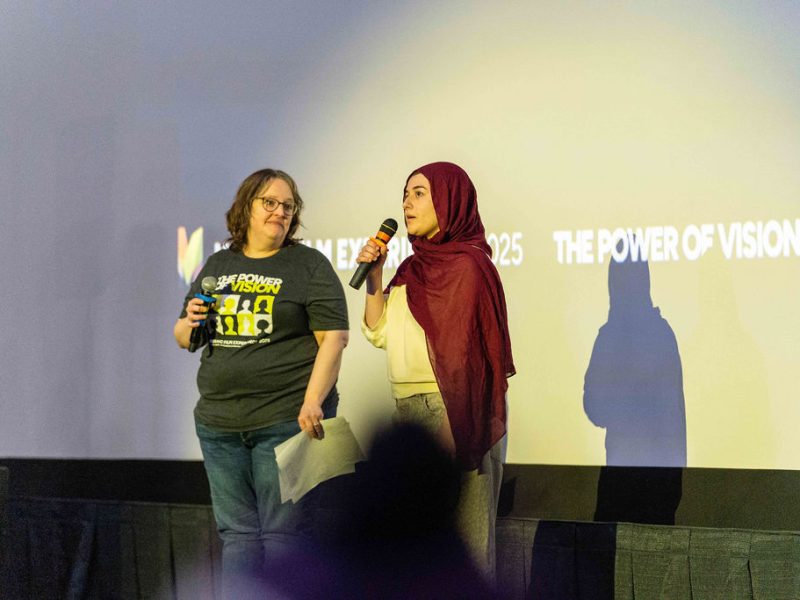In West Michigan’s booming tech scene, talent is the final piece of the puzzle
Local technology companies frequently can’t find enough trained professionals to fill their ranks, but the team behind West Michigan Tech Talent aims to help close the gap.

If you talk to West Michigan technology employers and entrepreneurs frequently, as we do at Rapid Growth Media, you’ll hear one refrain that pops up again and again: “Talent.” As in, “we need more of it.”

It may seem strange, but West Michigan tech companies are essentially sitting on a treasure trove of lucrative jobs, and their current challenge lies in finding talented professionals to fill them up.
It’s reached a point, says Tamara Iakiri, manager of talent acquisition at Grand Rapids-based Open Systems Technologies (OST), where many local technology companies are finding their growth more or less capped — not by a lack of available projects, but by a lack of staffers who can handle new work.
“I’m not sure why more people aren’t considering [technology careers],” Iakiri says, “because the numbers we see [of people studying those careers] keep going down and down. When we look at our business, our growth is tempered by how many talented people we can bring in.”
“We can keep getting new projects,” she adds, “but it doesn’t matter if we don’t have people to do them. So if we want to maintain a work-life balance for our existing staff, we can only grow so far.”
This picture isn’t unique to OST; it’s part of a growing trend in the West Michigan region. In January, Michigan’s chief information officer, David Behen, told Crain’s Detroit Business regarding the Michigan job forecast for IT professionals: “We always have openings, 50 to 70 at any one time. We’re always trying to fill those. The demand for IT talent is huge, and I see that continuing this year in all sectors.”
The chronic shortage of tech talent seems to fly in the face of the lush job forecast and lucrative compensation for Michigan tech professionals. The Bureau of Labor’s statistics on Grand Rapids and Wyoming, for example, show that the median hourly wage in 2013 for employees in “Computer and Mathematical Occupations” was $32.08, while the annual mean wage was $69,210.

The equivalent figures are even higher for some specialized areas within computer-related fields: software developers of systems software in GR-Wyoming, for example, checked in at $40.92 hourly and $85,810 annually. With those salary figures, Iakiri admits she’s not sure why more people aren’t exploring technology-related fields in their education or professional training.
She says that OST and other local employers aren’t content to simply sit back and complain about the situation, however. Instead, they’ve teamed up to create a project called West Michigan Tech Talent, aimed at addressing the local need for technology professionals in a comprehensive and grassroots fashion.
West Michigan Tech Talent initially came together about four months ago from a number of discussions between local economic development players The Right Place and regional workforce development organization Michigan Works!.
“We’d been having conversations about it for a while,” says Right Place business development manager Megan Sall, “and we agreed that talent is probably our number-one issue in West Michigan, whether it’s manufacturing or technology or anything. There’s definitely an overall sense that we need to be doing something collectively in order to grow, retain and attract more tech talent to the area.”
After their initial talks, Right Place and Michigan Works! quickly expanded their circle of partners to include the current core of the West Michigan Tech Talent team: OST, Spectrum Health, Atomic Object, Collective Idea, New Horizons, Kent ISD, GRCC, GVSU, Service Express, Inc., Elevator Up, and The Factory.

The various players worked together in collaboration to develop a ground-up strategy for training and educating greater numbers of technology professionals, and for raising public awareness regarding the benefits of employment in the West Michigan technology sector. They decided early on to divide their strategy into three different platforms, each with a simple, direct name and theme: Their “Grow” component focuses on young students in the K-12 age range; “Develop” specializes in helping current professionals acquire new tech skills or transition into the technology field; and “Recruit” aims to raise West Michigan’s profile in the regional and national consciousness as a technology hub and a thriving cultural outpost.
Iakiri, who heads up the “Grow” platform, says that Tech Talent has already started a number of initiatives to get kids more interested in technology careers. They’ve brought area students through OST and Amway for “talent tours” to observe and meet working technology professionals, helped host a local Bitcamp event for young girls, and applied for a local Grand Rapids chapter of Girls Develop It.
The mission, Iakiri says, is to get K-12 students familiar with the vibrant workplaces and wide range of career options that characterize the contemporary West Michigan technology scene.
“Maybe people have this stereotype that tech people are, you know, sitting in a dark corner with their heads down, not talking,” Iakiri says, “and I don’t think that’s what a technology career means at all. From a consulting perspective, it touches everything. We talk about that with all our students that come in — that no matter what you’re passionate about, whether it’s health care or the arts, there’s a connection to technology and a way you can leverage that.”
Sall agrees with Iakiri that reaching out to young students is critical in closing the technology job gap. She says that oftentimes, even four-year college graduates don’t have the complete package of skills needed to fill positions at Michigan’s more mature technology employers, and that getting young children familiar with technology — even including basic coding and programming skills — can set them ahead in technology literacy, and perhaps later allow them to come out of their education more fully prepared to enter the workforce in computer and IT fields.
“There are games and apps out there so that five-year-olds can be learning how to code,” Sall says. “They may not look like traditional code — it’s colors and shapes things, but — a friend of mine, her son goes to GR Makers sometimes, and he’s eight years old, and he codes there at Makers. It’s awesome, and it can be done.”
Despite the critical importance of reaching out to young people, West Michigan companies need talent in the immediate future as well, and so WM Tech Talent’s other platforms are focused on much shorter timeframes. Their “Develop” program, headed by Aaron Schaap from Elevator Up and The Factory, aims to connect current professionals with resources that they can use to develop new skills in technology, or to transition into a tech career from a different field.
With so many different collaborators in the Tech Talent project, Sall says that Develop can cast a wide net that will help mid-career professionals or underemployed workers address every aspect of career development, from finding relevant programs to applying for financial aid.
“Ideally, we’ll be looking at developing these people, and we can say, here’s the programs, here’s the means to get there,” say Sall. “We’ll be sort of taking a holistic look to get these people the programs they need and ultimately get them through the doors of employers.”
Finally, the “Recruit” program, led by Jim D’amico from Spectrum Health, plans to work on attracting current technology workers from other areas into West Michigan. They plan to accomplish some of this by helping provide recruitment education to local companies: for example, offering information on the sometimes-thorny H1-B visa application process so that companies can more easily bring in talented professionals from overseas.
A big part of the Recruit effort, though, involves branding Grand Rapids as a regional culture hub with a vibrant nightlife and a booming technology sector — not just a place people come to take one certain tech job, but a modern, urbanized community that people want to plan around when starting a family or looking to make a move from a major city.
As an early example of their Recruit efforts, they plan to partner with Hello West Michigan to put a “tech spin” on marketing efforts to attract people to West Michigan from major cities like Chicago. Additionally, they plan to leverage some of Grand Rapids’ major events and tourist attractions, like Laughfest and ArtPrize, as ways to get out-of-town technology professionals interested in West Michigan.
“It’s really about making people aware of the opportunities that are here,” Iakiri says. “You hear stories of people going to South by Southwest, and they’re like, ‘Hey, Austin is a cool place, I want to work here.’ So, how do we get people who come to Grand Rapids visit for Laughfest or ArtPrize to make the switch from, ‘Hey this is a nice place to visit,’ to, ‘Hey, this could be a place I want to live and work’?”
With local companies competing for tech professionals at a fairly feverish pitch, it seems like it might be difficult to get them all to sit down in a room together and agree to play nice, sharing resources and strategies for finding new tech workers.
Iakiri says, though, that all of the key players more or less had a feeling that the tech-talent problem wasn’t solving itself, and that it was time for local companies to come together in a concerted effort.
“We are looking for the same people,” Iakiri says, “and we know we’re not gonna benefit from just taking people from each other, and kind of re-circulating them. We’ve got to look at the longer term and bring fresh people in, as well as get people interested early, in the K-through-12 area, and take that full view of solving the problem.”
“It’s pretty grassroots,” adds Sall. “There are a lot of names behind what we’re doing, but mostly we just hit this point where we decided we had to do something. I mean anything’s better than nothing. So let’s at least get together, let’s start talking about ideas, let’s pool resources.”
As an example of what Tech Talent can accomplish just by opening up communication channels, Sall notes that when TT hosted their Bitcamp event, getting enough computers for all the attendees seemed to be an early issue. When they brought up this problem during a Tech Talent meeting, one of the attendees mentioned that they knew that the Michigan Economic Development Corporation had just purchased 20 Macbooks for a similar event on the East side of the state. Perhaps Tech Talent could just call up and ask to borrow them, he suggested.
One phone call later, GR Bitcamp was ready to roll with 20 new Macbooks.
“Sometimes it’s that easy,” Sall says, “but if [all of the different organizations are] operating alone in silos, nobody ever knows that the connections can be that easy.”
Iakiri says that West Michigan Tech Talent has accomplished a number of what she calls “small wins” for a relatively new project with no website up yet (although she promises one is coming soon). Besides the Bitcamp event and applying for Girls Develop It membership, she says that WMTT helped contribute to Kent ISD announcing a new position that will focus on technology education.
“It’s a small thing,” she says, “but it saved thousands of dollars and allowed us to get a program together that is repeatable, and then get it out to more and more students.”
Sall says that one of the group’s other important missions is simply to get local professionals who already work in the technology sector to share their stories, and maybe even brag about their community a bit as they network.
“I think we sometimes suffer here from being good, humble Midwestern folks,” Sall says. “We have a lot of people here who sometimes don’t like to tell their story — family-owned, private-owned companies, great companies, but they want to keep their head down and just work. And that’s great, but it’s very hard for us to attract talent when we can’t talk about all of these phenomenal stories.”
“Grand Rapids has so many facets,” Iakiri adds in agreement. “It’s such a multi-dimensional city, and we’ve been so good at promoting aspects of it, but now we need to work on others. If as many people knew about our technology as our beer, we’d be in great shape.”
Steven Thomas Kent is the editor at Roadbelly magazine and a high-tech, high-growth features writer at Rapid Growth Media. Stalk him on Twitter @steventkent or e-mail him at steven.t.kent@gmail.com for story tips and feedback.
Photography by Adam Bird









